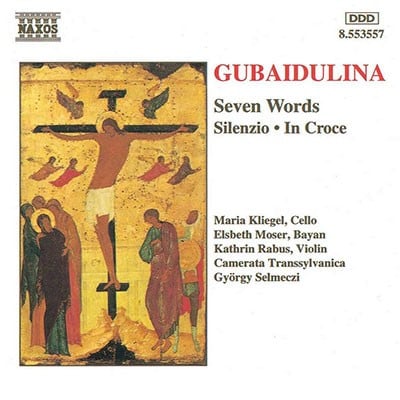str(5.4.3.2.1)
Abbreviations (PDF)
Sikorski
‘With reverence and respect for the great spiritual and cultural tradition, I have turned to a theme that Heinrich Schütz and Joseph Haydn had already inspired in the past: The seven last words of Jesus Christ on the cross, as found in the various Gospels.
Of course, a work that is purely instrumental cannot have the task of illustrating the Gospel text. This is more about purely tonal and instrumental metaphorical gestures. And in this respect, the two solo instruments, violoncello and bayan, as well as the string orchestra, provided me with a wealth of material. I am thinking, for example, of the protracted note in the violoncello, which is crossed (‘crucified’) by the glissando sound of the neighbouring string. In the bayan, this crossing happens with the help of special pressure on the neighbouring key. In the string orchestra there is the possibility of a glissando transition from unison to multi-octave and back to unison (= cross figure). When the cello bow moves behind the bridge, it is like entering another sphere.
These instrumental metaphors form the thematic basis of the work, which unfolds over the course of six movements with an incessant increase in tension. At the end of the 6th movement (‘Es ist vollbracht’), the tension is broken: The bow plays on the bridge. And in the 7th movement, the bow transcends the bridge - and thus, as it were, the limits of the instrument.
This basic theme, which is assigned to the solo instruments, is contrasted with the music of the string orchestra, which is reminiscent of choral singing in its character. These two thematic lines are joined by the threefold repetition of a five-bar quotation from the work of Heinrich Schütz: the melody to the exclamation ‘Mich dürstet’. This figure has an essential form-forming function.
The work is dedicated to the first performers Vladimir Toncha and Friedrich Lips, two remarkable musicians from Moscow, from whom it was greatly inspired. In the course of working on this work, they discovered numerous new playing possibilities on their instruments. For example, on the bayan: the simultaneous playing of a sustained and a glissando note, the crossing of a sustained note with two parallel glissando lines; or on the cello: enchanting, shimmering chords created by vibrating double harmonics, and much more. All of this owes its creation to the happy imagination of these brilliant musicians. I express my deep gratitude to them!’
(Sofia Gubaidulina)

Elsbeth Moser / Maria Kliegel /
Camerata Transsylvanica /
Gyorgy Selmeczi
Naxos 8553557

